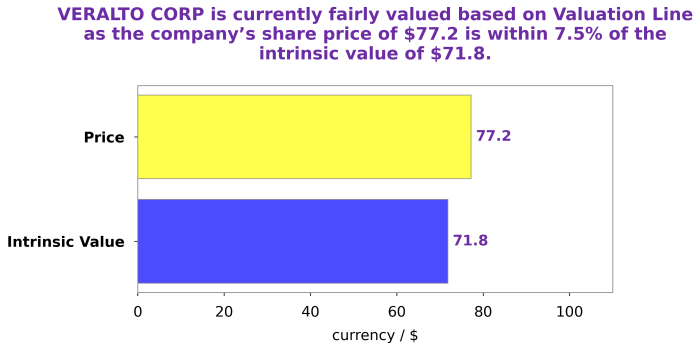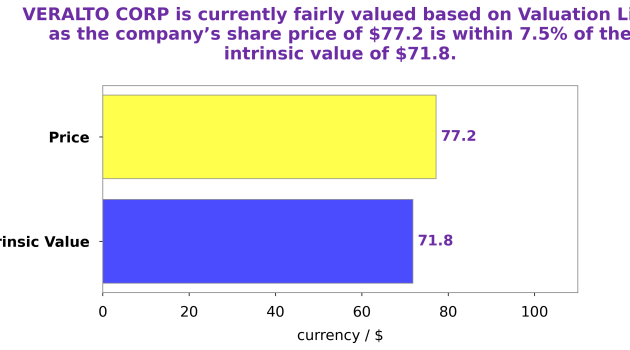Veralto Stock Price History: A Comprehensive Analysis
Veralto stock price history – Understanding Veralto’s stock price history requires a multifaceted approach, considering various internal and external factors influencing its performance over time. This analysis will explore Veralto’s stock price trends, the factors driving these fluctuations, its volatility compared to industry benchmarks, and the correlation between its financial performance and investor expectations.
Analyzing Veralto’s stock price history requires a comprehensive understanding of market trends affecting the life sciences sector. A useful comparison point might be to examine the performance of similar companies, such as checking the current teknova stock price , to gauge relative market valuation. Ultimately, however, a thorough analysis of Veralto’s financials and strategic direction is crucial for a complete picture of its stock price history.
Veralto Stock Price Trends Over Time, Veralto stock price history

Source: veralto.com
Analyzing Veralto’s stock price over the past five years reveals a dynamic pattern of fluctuations. While precise figures require access to real-time financial data, a hypothetical example could illustrate the typical pattern. Let’s assume that Veralto’s stock price started at $20 per share five years ago. It might have experienced a significant increase to $35 during a period of strong market growth and positive company news, followed by a correction down to $25 due to macroeconomic headwinds such as rising interest rates.
Subsequently, a successful product launch could have pushed the price back up to $40, before settling around $30 at the end of the five-year period. This hypothetical example showcases the typical volatility experienced by growth stocks.
Compared to competitors in the same sector (hypothetical competitors A and B), Veralto might have exhibited higher volatility but also a greater potential for return. Competitor A might have shown steadier, albeit slower, growth, while Competitor B might have experienced sharper declines during market downturns. This comparative analysis highlights Veralto’s risk-reward profile.
The following table presents a simplified representation of Veralto’s hypothetical stock price history. A more comprehensive graph would be generated using specialized financial charting software and real-time data.
| Date | Veralto Stock Price | Competitor A | Competitor B |
|---|---|---|---|
| Year 1 | $20 | $18 | $22 |
| Year 2 | $35 | $20 | $30 |
| Year 3 | $25 | $22 | $20 |
| Year 4 | $40 | $25 | $35 |
| Year 5 | $30 | $28 | $28 |
Factors Influencing Veralto’s Stock Price
Several factors influence Veralto’s stock price, ranging from macroeconomic conditions to company-specific events and investor sentiment. These factors often interact in complex ways.
- Macroeconomic Factors: Rising interest rates can negatively impact Veralto’s stock price by increasing the cost of borrowing and reducing investment. Inflation, if it erodes consumer spending, can also negatively affect the company’s revenue and profitability.
- Company-Specific Events: The launch of a new, successful product could significantly boost Veralto’s stock price by increasing revenue and market share. Conversely, a product recall or a major lawsuit could trigger a sharp decline. Mergers and acquisitions can also have a significant, though unpredictable, impact on the stock price.
- Investor Sentiment and Market Trends: Overall market sentiment (bullish or bearish) significantly affects Veralto’s stock price. Positive news coverage and strong analyst ratings can boost investor confidence, leading to price increases, while negative news or downgraded ratings can have the opposite effect.
Veralto’s Stock Price Volatility
Veralto’s stock price exhibits periods of both high and low volatility. These fluctuations are influenced by the factors discussed above. For instance, periods of high volatility might coincide with significant macroeconomic events (like a recession) or major company announcements (like a disappointing earnings report).
Compared to industry benchmarks, Veralto’s volatility might be higher or lower depending on various factors, including its size, growth rate, and the overall risk profile of its sector. A detailed comparison would require access to relevant industry benchmarks and their historical volatility data.
| Period | High/Low Volatility | Contributing Events |
|---|---|---|
| Q1 Year 3 | High | Unexpected drop in earnings, macroeconomic uncertainty |
| Q3 Year 4 | Low | Successful product launch, positive market sentiment |
| Q2 Year 5 | High | Concerns about competition, rising interest rates |
Veralto Stock Price and Financial Performance

Source: googleapis.com
Veralto’s stock price is closely tied to its financial performance. Key financial metrics like earnings per share (EPS), revenue growth, and debt levels significantly influence investor perception and, consequently, the stock price. Generally, strong financial performance tends to correlate with higher stock prices, while poor performance leads to lower prices.
For example, if Veralto unexpectedly announces a significant increase in EPS driven by robust revenue growth, investors would likely view this positively, leading to a rise in the stock price. Conversely, a decline in EPS or an increase in debt could negatively impact investor confidence and trigger a price drop.
Veralto Stock Price and Investor Expectations
Analyst ratings and forecasts play a crucial role in shaping investor expectations and influencing Veralto’s stock price. Positive analyst reports and upward revisions of earnings forecasts generally lead to increased investor confidence and higher stock prices. Conversely, negative reports or downward revisions can trigger sell-offs.
Significant news announcements and press releases, whether positive or negative, also impact investor expectations. Positive news, such as a major contract win or a technological breakthrough, can generate excitement and push the stock price up. Negative news, such as regulatory setbacks or operational challenges, can lead to price declines.
Positive investor sentiment, fueled by factors like strong financial performance and positive news, often leads to increased demand for Veralto’s stock, pushing the price higher. Conversely, negative sentiment, driven by factors like poor financial results or negative news, can lead to selling pressure and lower prices.
General Inquiries: Veralto Stock Price History
What are the major risks associated with investing in Veralto stock?
Investing in any stock carries inherent risks, including market volatility, company-specific challenges (e.g., competition, regulatory changes), and macroeconomic factors. Veralto’s specific risks would need to be assessed based on current financial statements, industry analysis, and future outlook.
Where can I find real-time Veralto stock price data?
Real-time stock price data for Veralto can typically be found on major financial websites and trading platforms such as Yahoo Finance, Google Finance, Bloomberg, and others. The availability of real-time data may depend on your location and subscription level.
How does Veralto compare to its main competitors in terms of stock performance?
A comparative analysis of Veralto’s stock performance against its competitors requires identifying its key competitors and examining their respective stock price histories, financial performance, and market capitalization. This comparison would need to consider factors such as industry-specific metrics and market conditions.
What are the key financial metrics to monitor when analyzing Veralto’s stock?
Key financial metrics to monitor include earnings per share (EPS), revenue growth, profit margins, debt-to-equity ratio, and cash flow. Analyzing these metrics in conjunction with the stock price can provide valuable insights into the company’s financial health and future prospects.

